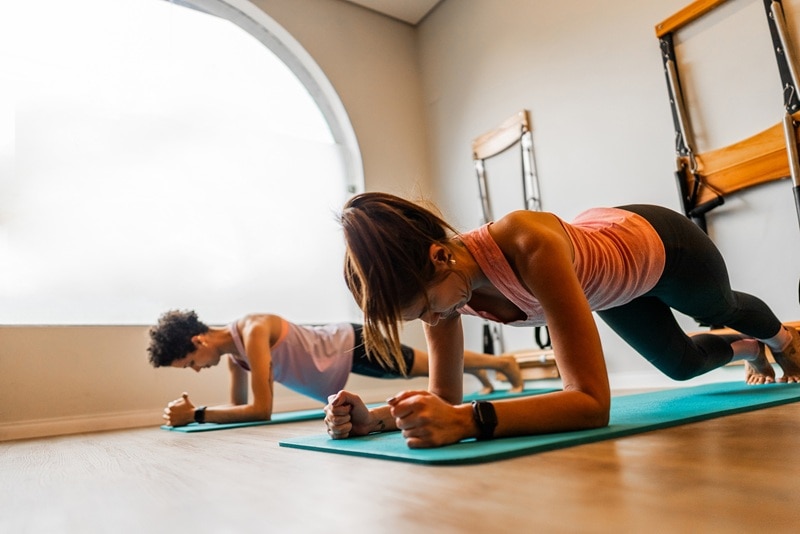Core workouts are a popular and important addition to any fitness routine, and women of all ages and abilities are lucky to have plenty of options to choose from. But so many options can often cause overwhelm, which can be a turnoff from even trying.
Here’s a pared down selection of some of the best core exercises for women who are looking to build functional core strength. Perhaps you are a beginner looking to start a routine or you’re returning from pregnancy, injury or another cause of extended time off.
Regardless of your situation, the goal is to provide some beginner-friendly core exercises for women with a few advanced options to tackle once you build some foundational core strength.
Core Exercises for Women: What are the Benefits?
It’s important to establish that core workouts target all of the muscles of the core, which include your abdominal muscles, lower back muscles, glutes and pelvic floor muscles.
Core workouts for women don’t just provide aesthetic benefits like helping you chase the ever-elusive look of chiseled abs. Rather, because the core is located centrally in the body, it plays a key role in connecting the upper body and lower body. This means that the core muscles help stabilize the spine and provide a reliable base of support for your pelvis and shoulder girdle so that your arms and legs can move efficiently and effectively.
Thus, regularly performing core exercises can provide the following benefits:
- Improving balance and stability, which may help prevent falls.
- Strong core muscles can support better posture, which reduces tension in the upper body and improves breathing.
- Decreasing symptoms of chronic low back pain and low back pain affects nearly 80% of adults at some point in their lifetime.
- Studies show that regularly performing core workouts can improve lower limb function, which may lower the risk of sports or work-related injuries.
- Strengthening your diaphragm, which can improve breathing mechanics.
- The best core workouts strengthen the pelvic floor muscles, which can help manage symptoms of urinary incontinence.
- Improving functional stability and strength for everyday activities.
- Increasing mind-body awareness.
What Are the Best Core Exercises for Women?
Note that while this article is geared toward the strength training needs of women, these exercises can be beneficial for anyone, no matter your biological sex or gender identity.
That said, some women have specific needs for core strengthening based on lifestyle and life stage events such as pregnancy and hormonal changes associated with menopause. Pregnancy and childbirth can damage the abdominal wall and pelvic floor and disrupt the continuity of the muscle groups. Additionally, as women age, changes in the hormonal profile can weaken the pelvic floor muscles and make it more difficult to control these small, but key, muscles.
Below are some of the best core exercises for women:
Plank
There are all sorts of plank exercises and plank challenges you might find online, but mastering a basic forearm plank is a good way to build core strength. There’s plenty of time down the road to build upon the forearm plank exercise as you get stronger.
- Get into a push-up position, but drop down so that your forearms are on the mat with your elbows directly below your shoulders. Your body should be in a straight line from your head to your feet.
- Engage your abs by drawing your belly button up to your spine. Squeeze your glutes and pelvic floor muscles to hold this position.
- Keep your head and neck in a neutral position with your gaze down at your mat.
- Hold the pose for 10 to 60 seconds, depending on your strength level. Keep in mind that it is much more important to maintain proper form rather than hold the pose for a longer period of time. You can always rest and then do another 10 seconds.
Over time, you can progress the basic plank exercise by lifting up one arm or leg at a time for 2-3 seconds. Remember to keep the rest of your body in that strong, solid plank without twisting or shifting your pelvis or shoulders or dropping your butt down.
Side Plank
Side planks take the standard forearm plank and turn it on its side to target your obliques, erector spinae and transverse abdominis muscles.
Beginners can start with a modification that involves keeping your knees on the ground so that you are just doing the plank position from the knees to the forearm. As you get stronger, lift your entire lower body into the plank position keeping a straight line from your armpit to your feet.
You can also stagger your feet instead of stacking them on top of each other. This means that you can place the foot of the top leg on the floor in front of or behind the supporting foot so that you have a wider base of support. Gradually wean off of this modification so that your feet are stacked on top of one another.
- Lie on one side with your elbow lined up directly under your shoulder and your feet stacked on top of one another.
- Use your core muscles to lift your hips off the ground. Extend the arm facing the ceiling all the way up straight rather than touching down on the mat, but if you need a little bit of support at first, you can lightly make contact with your mat.
- Engage your core muscles and glutes to maintain this strong position. Remember that your body should be in a straight line from your head down to your feet. Your hips need to be in line with your body.
- Hold the position for 15 to 30 seconds and then reset and switch sides.
Bird Dog
This core exercise strengthens your spinal stabilizers and glutes and helps train your body to provide core stability while your limbs are moving.
- Get in a tabletop position by kneeling on all fours with your wrists stacked under your shoulders and your knees under your hips. Your back should be nice and flat rather than rounded.
- Simultaneously lift and extend the opposite arm and leg while keeping this flat tabletop as stationary as possible. Reach the arm forward in front of your head so that it’s straight and parallel to the floor while you lift the leg on the opposite side of the body straight back so that it’s also parallel to the floor.
- Make sure that your glutes and core muscles are engaged so that you aren’t twisting your trunk or shifting out of the tabletop position.
- Bring the arm and leg back in towards the starting position but before you drop them back down to the mat, continue past the neutral starting position until you touch your elbow and knee together underneath your chest.
- Repeat on the opposite side, remembering to move in a slow and controlled fashion.
- Complete 10 to 12 reps per side.
Dead Bug
The dead bug exercise may have an unappealing name but it is great for building core stability by strengthening your lower abs and pelvic floor muscles.
- Lie on your back with your knees bent 90 degrees and your arms straight up, pointing towards the ceiling.
- Engage your abs to lift your feet off the floor so that your shins are parallel to the floor and your knees are still at that 90° angle straight up from your hips. Essentially, you are in a reverse tabletop position.
- Make sure that your abdominal muscles are engaged and that your lower back is touching the floor. This involves recruiting those deep abdominal muscles. This is the starting position.
- Slowly lower your right leg until your heel almost touches the floor while you simultaneously extend your left arm back behind your head towards the floor without touching it. Again, this is sort of like the reverse of the bird dog exercise.
- Hover the foot and hand above the floor for one or two seconds and then bring them back up to the starting position.
- Repeat the movement with your opposite arm and leg. Remember to move as slowly as possible to maximize the benefits of this core exercise.
- Keep alternating sides with each rep until you complete 15 reps per side.
As you get stronger, you can wear ankle weights for added resistance.
Bulgarian Split Squat
The Bulgarian split squat with rotation is an advanced core exercise that also strengthens your entire lower body. You can perform it at home even if you don’t have dumbbells by holding a heavy object and using a stair or coffee table behind you.
Ideally, perform the exercise in a gym with a weight bench or plyometric box behind you, holding a dumbbell or kettlebell.
- Stand facing away from a stable bench or chair that’s about knee height. You should be about 2 ft in front of it with your legs shoulder-width apart.
- Hold a dumbbell or weighted object between your two hands in a vertical position in front of your chest. Keep your elbows tucked into your sides.
- Facing away from the bench and keeping your core tight, extend your left leg backward and place that foot on the bench so that the laces of your shoes touch the bench.
- Keeping your torso upright and core engaged, bend both knees to slowly lower into a lunge. Your left knee should hover just above the floor without touching it while your right knee should be at a right angle in front of your body.
- In the lower position, extend your arms straightforward with the weight and rotate your trunk slowly to one side and then back to neutral using your core. Beginners can skip the rotation and just keep holding the dumbbell in towards the chest.
- Rotate to the other side.
- Push your right heel into the floor to stand back up into the starting position.
- Switch legs and complete 8-10 reps per side.
If you are not yet comfortable enough with your balance and strength, you can keep both feet on the ground rather than elevating the rear foot.
Beginners should start with one set of the exercises above, two or three times per week. Build up to three sets.
After your core strength workouts, refuel with a protein-rich snack and drink plenty of water.




